| Sonnet 121 | |||||||
|---|---|---|---|---|---|---|---|
 Sonent 121 in the 1609 Quarto | |||||||
| | |||||||
| |||||||
Sonnet 121 is one of 154 sonnets written by the English playwright and poet William Shakespeare. It is a member of the Fair Youth sequence, in which the poet expresses his love towards his young lover.
| Sonnet 121 | |||||||
|---|---|---|---|---|---|---|---|
 Sonent 121 in the 1609 Quarto | |||||||
| | |||||||
| |||||||
Sonnet 121 is one of 154 sonnets written by the English playwright and poet William Shakespeare. It is a member of the Fair Youth sequence, in which the poet expresses his love towards his young lover.
The poet condemns hypocrisy and decides he's going to be himself.
Hypocrites force you to lose out on life's fair pleasures.
They are bad by pointing out your faults may actually be a good thing.
You have to hide your pleasurable pursuits from them.
Unless they realize that all people are bad (and presumably they will stop being hypocrites)
Sonnet 121 is an English or Shakespearean sonnet. The English sonnet has three quatrains, followed by a final rhyming couplet. It follows the typical rhyme scheme of the form ABAB CDCD EFEF GG and is composed in iambic pentameter, a type of poetic metre based on five pairs of metrically weak/strong syllabic positions. The 1st line exemplifies a regular iambic pentameter:
× / × / × / × / × / 'Tis better to be vile than vile esteem'd, (121.1)
Four lines (2, 4, 9, and 11) have a final extrametrical syllable or feminine ending, as for example:
/ × × / × / × / × /(×) Not by our feeling, but by others' seeing: (121.4)
Line 4 (above) also exhibits another common metrical variation, an initial reversal. Initial reversals are potentially present in lines 7, 8, and 11. The 3rd line features one (potentially two; the second can be otherwise scanned) rightward movements of an ictus (resulting in a four-position figure, × × / /, sometimes referred to as a minor ionic):
× × / / × / × × / / And the just pleasure lost, which is so deem'd (121.3)
A similar minor ionic is potentially present in line 12's "By their rank thoughts", though not if "their" receives contrastive accent.
The meter demands that line 13's "general" function as two syllables.
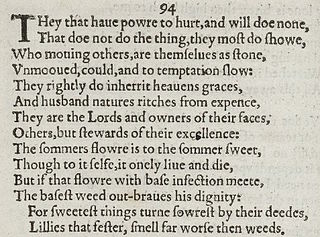
Sonnet 94 is one of 154 sonnets written by the English playwright and poet William Shakespeare. It is a member of the Fair Youth sequence, in which the poet expresses his love towards a young man.

Sonnet 10 is one of 154 sonnets written by the English playwright and poet William Shakespeare. It is a procreation sonnet within the Fair Youth sequence.
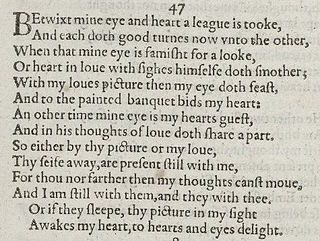
Shakespeare's Sonnet 47 is one of the Fair Youth sequence, addressed to a well-born young man. More locally, it is a thematic continuation of Sonnet 46.
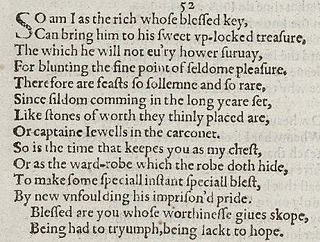
Sonnet 52 is one of 154 sonnets written by the English playwright and poet William Shakespeare. It is a member of the Fair Youth sequence, in which the poet expresses his love towards a young man.

Sonnet 61 is one of 154 sonnets written by the English playwright and poet William Shakespeare. It is a member of the Fair Youth sequence, in which the poet expresses his love towards a young man.

Sonnet 91 is one of 154 sonnets written by the English playwright and poet William Shakespeare. It's a member of the Fair Youth sequence, in which the poet expresses his love towards a young man.
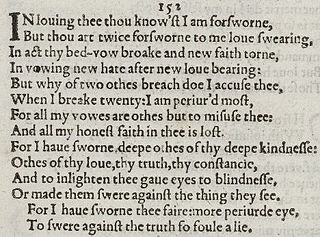
Sonnet 152 is a sonnet by William Shakespeare. It is one of a collection of 154 sonnets, dealing with themes such as the passage of time, love, beauty and mortality, first published in a 1609.
Sonnet 149 is one of 154 sonnets written by the English playwright and poet William Shakespeare.

Sonnet 142 is one of 154 sonnets written by the English playwright and poet William Shakespeare.

Sonnet 139 is one of 154 sonnets written by the English playwright and poet William Shakespeare.

Sonnet 131 is a sonnet written by William Shakespeare and was first published in a 1609 quarto edition titled Shakespeare's sonnets. It is a part of the Dark Lady sequence, which are addressed to an unknown woman usually assumed to possess a dark complexion.

Sonnet 75 is one of 154 sonnets written by the English playwright and poet William Shakespeare. It is a member of the Fair Youth sequence, in which the poet expresses his love towards a young man.

Sonnet 119 is one of 154 sonnets written by the English playwright and poet William Shakespeare. It's a member of the Fair Youth sequence, in which the poet expresses his love towards a young man.

Sonnet 90 is one of 154 sonnets written by the English playwright and poet William Shakespeare. It is a member of the Fair Youth sequence, in which the poet expresses his love towards a young man.
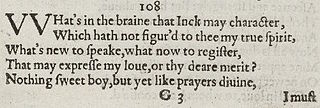
Sonnet 108 is one of 154 sonnets written by the English playwright and poet William Shakespeare. It is a member of the Fair Youth sequence, in which the poet expresses his love towards a young man.

Sonnet 111 is one of 154 sonnets written by the English playwright and poet William Shakespeare. It is a member of the Fair Youth sequence, in which the poet expresses his love towards a young man.
Sonnet 113 is one of 154 sonnets written by the English playwright and poet William Shakespeare. It's a member of the Fair Youth sequence, in which the poet expresses his love towards a young man.

Sonnet 114 is one of 154 sonnets written by the English playwright and poet William Shakespeare. It is a member of the Fair Youth sequence, in which the poet expresses his love towards a young man.

Sonnet 115 is one of 154 sonnets written by the English playwright and poet William Shakespeare. It is a member of the Fair Youth sequence, in which the poet expresses his love towards a young man.
Sonnet 120 is one of 154 sonnets written by the English playwright and poet William Shakespeare. It's a member of the Fair Youth sequence, in which the poet expresses his love towards a young man.